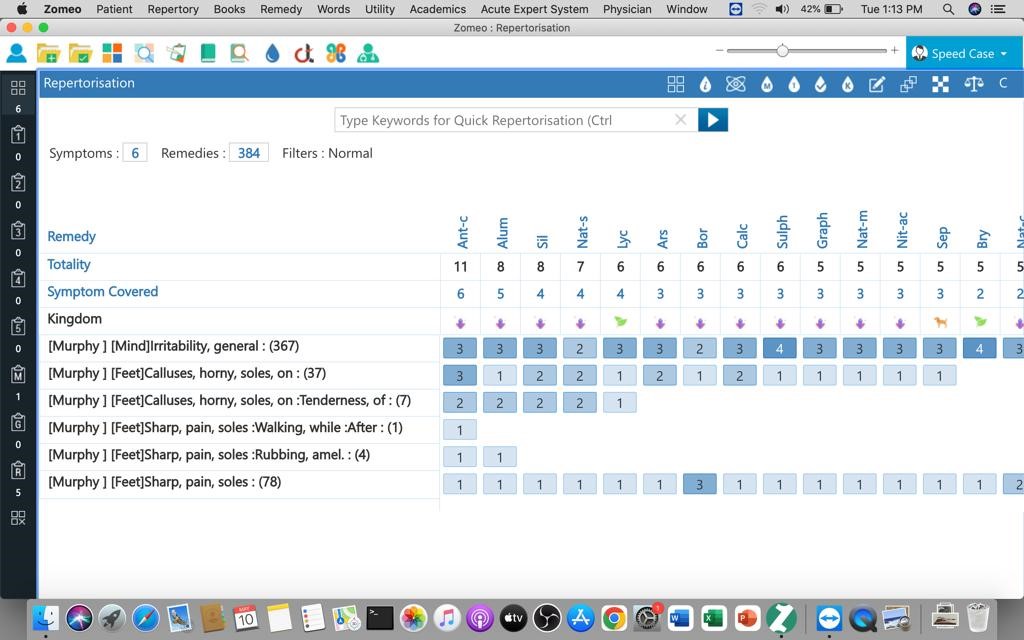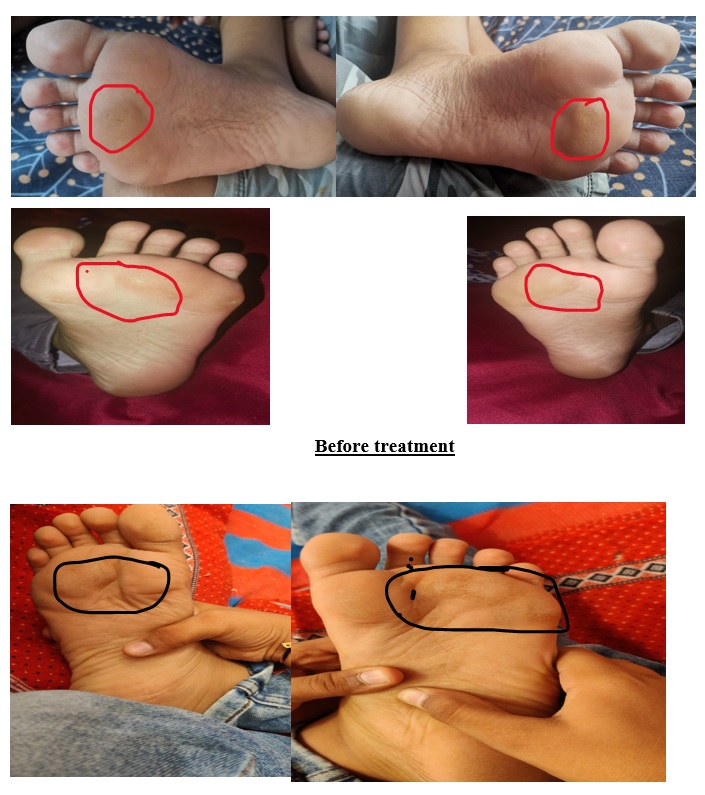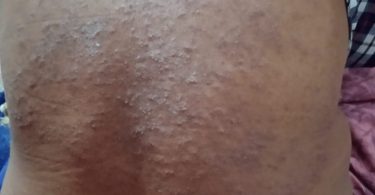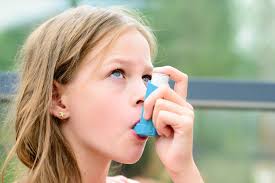
ABSTRACT: The most common complaint of foot skin is callus. Thickening of the skin, which is because of improper walking styles with different footwear or frequent friction to the area of skin. These feel lumpy on touch and less sensitive to touch. Now-a-days it is a major problem in every individual. This article is regarding a case study with homoeopathic management.
KEYWORDS: plantar callosities, Antimonium crudum, homoeopathy, VAS scale.
ABBREVATIONS: visual analogue scale (VAS), thrice a day (TDS)
INTRODUCTION: –
Callus, is the most common complaints of foot skin experienced by individuals of all the ages. A callosity is nothing but a greatly thickened and cornified ceases at the periphery and then continued with the normal skin1. It can be broadly said as diffuse area of hyperkeratosis of relatively even thickness, most commonly seen under metatarsal heads2.These calluses are painful and unsightly lesions often result in disability3.The healthy plantar skin is essential to our well being4. Healthy function of the plantar skin surface is necessary for the individual to stand, walk or run efficiently If there is formation of any blisters, fissure or callus the resulting discomfort may completely incapacitate the individual concerned. The terms like tyloma or clavus are sometimes used to denote callus1.Plantar calluses, like all calluses, form in response to pressure or friction to protect the skin underneath from damage. Callosities of the plantar skin are commonly seen nowadays due different or modern footwear habits. Callosity can be defined as a raised patch of hyperkeratosis, increased thickening of epidermis of stratum corneum and granular layer, seen in areas of excessive pressure or repeated trauma4. Callosities can be painful and the symptoms may be so intense as to seriously affect a person’s gait and other activities.
Factors that lead to development of callosities: –
EXTRINSIC FACTORS –
- Poor footwear, tight shoe, irregularities in shoe, open shoes, activity level athletes.
INTRINSIC FACTORS –
- Prominent condylar projection, malunion after a fracture, bony prominences.
- Cavovarus foot, toe deformity (claw, mallet), hallus rigidus, short first metatarsal2.
Pathology:
Callus (plantar keratotic lesions) are associated with elevated mechanical stresses over prominent and deformed joints4. During normal keratinisation, epidermal cells differentiate into horn cells that are lost from the surface of the stratum corneum during desquamation. In some conditions, there is failure of the binding forces between the corneocytes near the surface and formation of the cornified cells leads to hyperkeratosis. However, the details of the alterations in the epidermis and the stratum corneum that take place and lead to hyperkeratosis are unknown2.
CLINICAL FEATURES:
- Callosity presents as a thick skin in the areas of excessive pressure4.
- Initially painless, later painful
- Sensitive to touch the affected area
- Thickening or hardening of the affected area
- Soreness
GENERAL MANAGEMENT:
- Regular sharp scalpel debridement1
- Gentle trimming with the pumice stone
- Not painful – only cosmetic – sock the legs in warm water and use pumice stone
- Advising on the footwear
- Use of silicone sleeves1
- Use of keratolytic agents, i.e. 10-15% salicylic acid are beneficial1
HOMOEOPATHIC MANAGEMENT:
- ANTIMONIUM CRUDUM [Sb2S3]
Tendency to grow callosities – slightest pressure will produce a sore place or callosity, and in working men you will find an unusual tendency to thickening of skin on the soles of the feet. They are very sore to walk upon because these calluses places are sensitive. It has a tendency to build-up and indurate6. Callosities on soles of feet with excessive tenderness can only walk with pain and suffering7. Feet very tender covered with large horny places 8. All conditions aggravated by heat and cold bathing, Ameliorated by rest9.
- RANUNCULUS BULBOSA
Indicated for callous and other excrescences(growths). painful stiffness in joints of feet. Indicated for horny excrescences8. Modalities; conditions aggravated by motion, contact, especially wet, stormy weather9.
- SILICEA
It has the promoting and controlling the process of inflammation and suppuration. Hard painful callosities on soles-voluptuous tickling in soles which when the part has been scratched a little is almost maddening. Numbness of feet in the evening, burning sensation in feet and soles especially evening, night. Cramps in the soles of feet8. Soreness in the feet from in step through to the sole. It has got a tendency to promote and expel foreign bodies from the tissues where they may be lodged. Modalities; conditions aggravated by morning, from washing, cold. Ameliorated by warmth, summer9.
- THUJA
Lower limbs feel like wood when walking in open air. Pains in the feet and ankles after suppressed gonorrhea – could not walk. Numbness of foot – nets of veins as if marbled on soles of feet, Red marbled spots on in step8.
CASE
REPORT
Name – abc
Age – 10 years
Sex – Male
Marital status: – Unmarried
Occupation: -Student
Address: – xyz
Dated: -30-11-2020
Presenting complaints: -Pain in both soles since15 days
History of presenting illness: –
Patient was apparently healthy 1 month back ago. Then slowly, he observed thickening of skin over the forefoot, first in right leg and then to left leg. Those thickenings were painless for first 15 days. Later in the last 15 days, patient experienced a sharp pain over the soles while walking or putting pressure over the soles. Pain was aggravated after walking and ameliorated on rubbing the foot. Tenderness was present over both forefeet.
Past history: –Patient suffered from dengue fever 2 years ago.
No history of any major illness.
Family history: -Father suffered with the similar complaint 10 years back – undergone surgery.
Personal history: –
Diet: – mixed
Appetite-:3 times/day, satisfactory
Desires: -sweets
Thirst: – 3-4 litres/day, small quantity in frequent intervals
Perspiration: -generalised on exertion
Sleep: – 8-9 hours per day, refreshed sleep
Thermals: -chilly
Mental generals: –The patient was so irritable during the case taking. He wasn’t allowing any one to touch him. when asked the questions repeatedly, he used to get irritated and didn’t answer well. When he asked for something and if it was not given, he used to get irritated and shouted at that person.
General physical examination-
Vital signs
- Pulse rate- 74/minute
- Blood pressure- 120/80 mm of hg
- Heart rate- 74beats per minute
- Respiratory rate- 16 breaths/min
- Height- 5.2feet
- Weight- 55 kgs
- Temperature- Afebrile
Physical appearance
- Patient was moderately built, wheatish complexion. No signs of clubbing, cyanosis, lymphadenopathy, oedema and pallor.
Examination of affected part
Inspection – Thickening of skin in forefoot of both the foot is present. The thickenings were of irregular shape and had spread over the forefoot of the feet. No deformity of foot was observed.
Palpation – Tenderness on touching the affected area was present. Skin was rough and hard on palpation.
Diagnosis: Plantar callosities10
Diagnosis was based on clinical symptoms and physical examination of the patient
Plantar callosities –
- Thickening over the forefoot
- Pain on pressure or walking
- Sensitive to touch10
Analysis and evaluation of symptoms:
Mental generals – irritability++
Particulars:
- Callus over forefoot of both feet
- Tenderness of the callus
- Sharp pain over the soles of feet+++
- Sharp pain aggravated after walking
- Sharp pain ameliorated by rubbing
Totality of symptoms –
- Mind – irritability++
- Feet – soles- calluses
- Feet – soles-calluses-tenderness++
- Feet – soles-sharp pain+++
- Feet – soles-sharp pain – aggravated after walking
- Feet – soles- sharp pain – ameliorated on rubbing

Prescription: -Date: -30-11-2020
Antimonium crudum 200 / 3 doses, early morning for 3 alternating days along with placebo every day, two times a day after eating food for 15 days.
Pain assessment: -intensity of pain was assessed using VAS scale
The patient marked 9 points on VAS scale on date of the visit.

Post treatment
Selection of potency: –According to the susceptibility of the patient, the potency was selected according to aphorism 2475. Patient being a child, he was highly susceptible and intensity of the pain was also high, so considering this in case, started with the high potency.
Repetition of medicine: – Fromaphorism 246 inOrganon of Medicine5, the well-chosen remedy should be repeated at regular intervals considering the duration of the disease. In this case, there was improvement in the intensity of pain so there was no requirement to repeat the medicine. Placebo was then prescribed.
Follow- up
| Date | Symptomatology | Prescription |
| 14-12 2021 | Irritability was mildly reduced Callus hardness decreased Pain in the forefoot reduced VAS scale score was 6 | Placebo 30/ TDS/15days |
| 29-12-2021 | Irritability reduced; callus is present but no pain is present VAS scale score is 3 | Placebo 30 / TDS/ 15 days |
| 12-01-2021 | Irritability reduced; callus present without any pain VAS score is 1 | Placebo 30/TDS/15days |
Conclusion: -With the help of symptom similarity, homoeopathy does miracles in managing the pain in different chronic conditions. In this case, the pain has been completely reduced with treatment but skin hardenings will disappear when the mechanical forces are removed, i.e. proper footwear, orthoses.
REFERENCES: –
- Singh D, Bently G, Trevino SG, callosities, corns and calluses, BMJ. 1996 June ;312(7403); 1403-6, doi:10.1136/bms.312.7043.1403a. PMID:8646101:PM CID:PMC2351151. Available from – https://pubmed.ncbi.nlm.nih.gov/8646101/
- Sharon E. Thomas, Peter J. Dykes, Ronald Marks, Plantar Hyperkeratosis: A Study of Callosities and Normal Plantar Skin, Journal of Investigative Dermatology, Volume 85, Issue 5,1985, Pages 394-397, (https://www.sciencedirect.com/science/article/pii/S0022202X15438163)
- Hashmi F, Nester CJ, Wright CR, Lam S. The evaluation of three treatments for plantar callus: a three-armed Randomized, comparative trial using biophysical outcome measures. Trials. 2016 May 17;17(1):251. DOI: 10.1186/s13063-016-1377-2. PMID: 27189190; PMCID: PMC4869362.
- Davys H. J., Turner D. E., Helliwell P. S., Conaghan P. G., Emery P., Woodburn J., Debridement of plantar callosities in rheumatoid arthritis: a randomized controlled trial, Rheumatology, Volume 44, Issue 2, February 2005, Pages 207–210, https://doi.org/10.1093/rheumatology/keh435
- Hahnemann S. [1833] Organon of medicine, 5thedition, Mayor Jain, Indian books and periodicals publishers. Pg:252,253.
- Kent JT. [2015] Lectures on Homoeopathic Materia Medica, B Jain publishers (P) Ltd, Pg:109.
- Nash E.B. [ 2014] Leaders in homoeopathic therapeutics, 1st Indian Edition, Mayur Jain Indian books and periodicals publishers Pg:36.
- Clarke J.H. [2020] A Dictionary of practical Materia Medica volume 1, B. Jain publishers (P) Ltd pg:125,1187,950-51,1435.
- Boericke W. [2018] Pocket manual of Homoeopathic Materia Medica & Repertory Mayur Jain Indian books and periodicals publishers (p). Ltd. Pg:57,593,545.
- Rao SD. [2015] Clinical manual of surgery , Reed Elsevier India Private limited.Pg:71.
- Das S. [2018] A concise textbook of surgery 10th edition, Dr. S Das 13, Old Mayor’s court Kolkata. Pg:373.
About the Author.
Dr T Surekha Assistant professorDepartment of community medicineMNR HOMOEOPATHIC MEDICAL COLLEGE AND HOSPITAL Sangareddy
2. S.Dheeraj Intern, MNR HOMOEOPATHIC MEDICAL COLLEGE AND HOSPITAL Sangareddy3. A MaheshwariIntern, MNR HOMOEOPATHIC MEDICAL COLLEGE AND HOSPITAL Sangareddy




